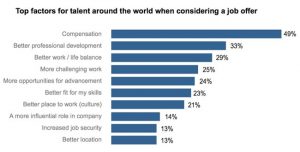— December 27, 2017

geralt / Pixabay
There are so many myths surrounding employee recognition programs that it’s impossible to keep what is true and what is false straight! Here are three myths that needed to be addressed, especially going into the new year.
Myth 1: Recognition Should Only Be For Truly Remarkable Deeds
Remarkable deeds are simply not the only time you should show any form of recognition to your employees. By all means, do give your employees attention and praise when they accomplish something noteworthy, but watch what goes on day-to-day as well.
By observing the small things they do, such as always showing up on time, or always being willing to proofread coworkers work, you will see the small quirks that set them apart from everyone else. It’s when we focus on these regular tasks that we start to be appreciated.
If a housewife makes dinner, does the dishes, and puts the children to bed without being appreciated, she might become unhappy over time. However, if her partner showed regular appreciation and did not take her for granted, then the wife will likely remain happy in the marriage.
Since employees are people, we need to treat them well by maintaining a healthy relationship. Just like the wife in the example, if the employee is never thanked for the regular daily things they do, they will begin to think they aren’t being appreciated. Morale will lower, performance will drop, and there will be other behavioral issues that arise.
While the big deeds definitely deserve attention, make sure you do not forget about the simple things your employees do on a day-to-day basis. Treat your employees like family members and they will be engaged and loyal for years to come.
Myth 2: You Need an App
With the ever-growing need for smartphone accessibility, employee recognition programs are often criticized for not having a mobile application. After all, users should be able to access the recognition solution from their phones, especially since not all employees spend their day in front of a computer. Companies want a solution their users can access easily since participation is key to program success.
I would be the first to agree with that. Employees need to be able to access their employer’s recognition portal on their cell phones, tablets, and other devices. But an app you can buy from an app store might not be the solution you’re looking for.
Apps are bulky. The app takes up room on your mobile device and updates need to be downloaded. This can be particularly annoying to users who have minimal storage space on their device. Also, with frequent feature releases and changes to the program, the app would need to be updated often.
What if there was a solution to this problem, where your users can access the program on their smartphones, with a device-friendly interface, where the application does not take up storage space on the device, and your users don’t have to download updates? Well, it just so happens that there is!
There is a lesser known trick with smartphones where you can make an icon on your phone’s home screen that links directly to a website. All it takes is to follow three easy steps and you have a shortcut!
- Simply open the website browser of your choice (Safari, Chrome, etc) on your device and go to the recognition program website.
- On the mobile web browser, click on the Information button (usually the letter ‘i’ inside a circle or a few vertical dots, depending on your phone).
- Finally, click the “Add to Home screen” button (it may say something similar, depending on your phone).
Now, whenever you click on that icon from your phone’s home screen, you will be brought to the website as if it was a mobile app.
If the recognition software provider is worth their salt, they will have made the solution in a way that it recognizes the size of the screen. That way, whether you have a full screen on a computer, a half screen on a computer, a tablet, an iPhone, or any size or variety of smartphone technology, you will see a smooth-looking website design. Most of your users wouldn’t even be able to tell it’s any different from an app.
This technique allows product updates to be released regularly without constant update notifications being sent to your users and the program takes up no space on the device.
Myth 3: Recognition Should Only Ever Come From The Top Down
There is this common misconception that recognition should only ever come from the top down. For some reason, people think that it’s weird that employees should recognize their bosses, but that is a silly concern. Spreading recognition, particularly non-monetary recognition should be a thing that everyone can do. If only supervisors recognize their employees, it does not build the community. Rather, it solidifies silos.
While your company may require a strict hierarchical order for communication across thousands of employees, when it comes to building your company culture, you do not want to forbid employees from recognizing each other or their supervisors.
Many companies will give managers the ability to assign monetary value to recognition awards, however, these companies almost always have some sort of “free” social recognition option where any employee can send any other employee a thank you, high five, or other type of message. This allows connections to build through appreciation. Whether it is an employee recognizing another employee, a manager recognizing their employee, or a lower level employee recognizing a supervisor, a thank you or congratulatory messages can come from anywhere.
Business & Finance Articles on Business 2 Community
(84)
Report Post



